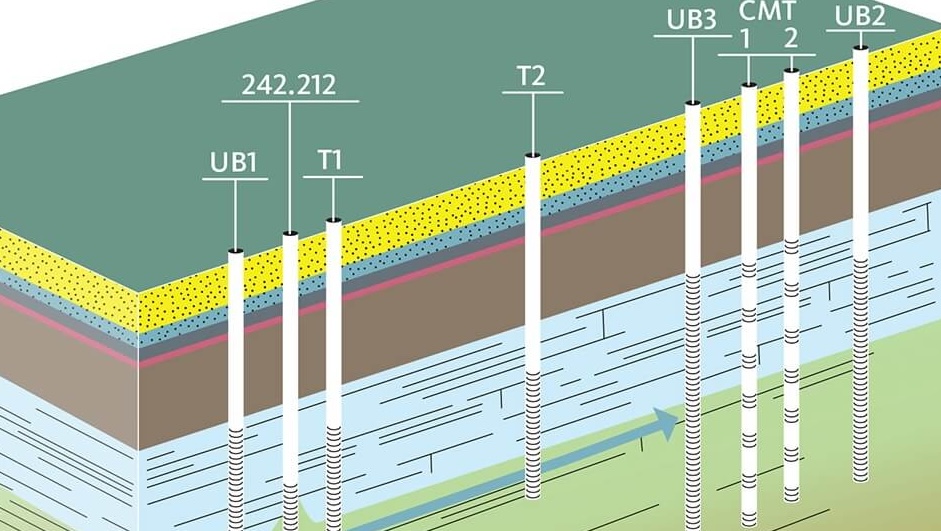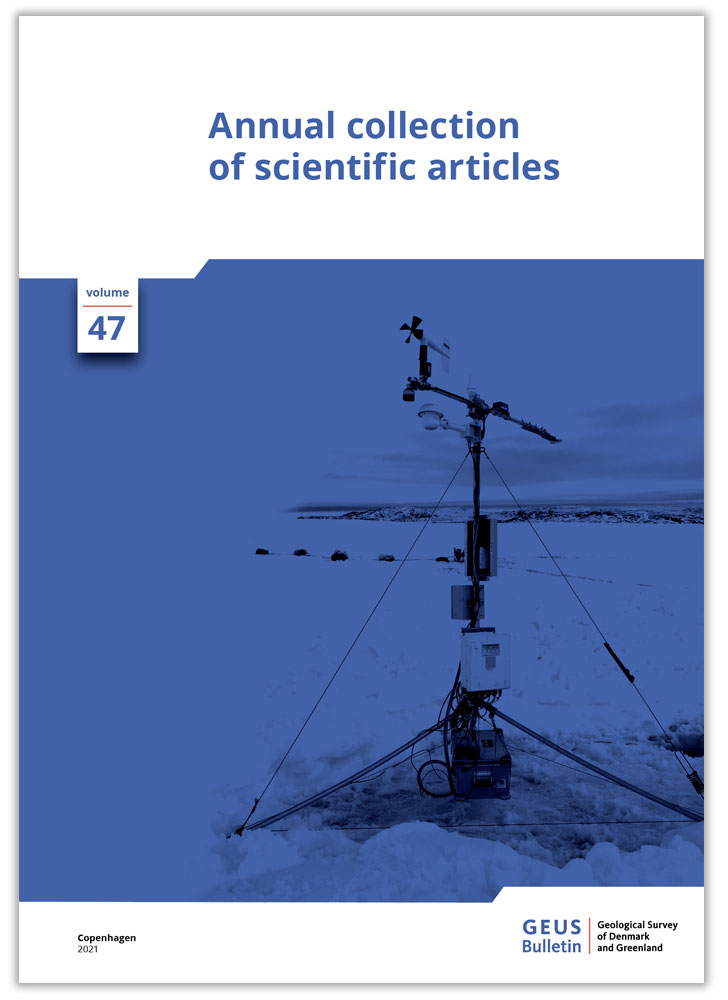
How to Cite
Share
Abstract
Salinity levels above the drinking water standard (>250 mg/l Cl–) are observed at shallow depth in a Maastrichtian chalk aquifer on the island of Falster, south-eastern Denmark. To understand the source of the salt, 63 samples from 12 individual, 1 m, screened intervals between 14 and 26 m b.s. were collected from 1 May to 4 June 2018. The samples were collected during a tracer test to estimate the dual porosity properties of the chalk and were analysed for a wide range of elements. Furthermore, samples from the Baltic Sea and from deeper saline aquifers in the area (40 and 85 m b.s.) were analysed for comparison. The geochemical data were analysed using an unsupervised machine-learning algorithm, self-organising maps, to fingerprint water sources. The water composition in the screened intervals at various stratigraphic levels has specific geochemical fingerprints that are maintained for the first days of pumping and are distinct amongst the different levels. This suggests an evolution in water composition because of reaction with the chalk. Water composition is distinct from both seawater from the nearby Baltic Sea and salty water from deeper levels of the reservoir. Thus, neither up-coning of salty water nor intrusion of seawater caused the elevated salinity levels in the area. The slightly saline composition of groundwater in the shallow aquifer (14–26 m b.s.) is more likely because of incomplete refreshing of the salty connate water in the chalk during the Pleistocene and Holocene. Furthermore, the geochemical fingerprint of salty water from the deeper aquifer at 40 m was similar to water from the Baltic Sea, suggesting a Baltic Sea source for salt in the aquifer at 40 m b.s., c. 100 m from the coast. Statistical analysis based on self-organising maps is an effective tool for interpreting a large number of variables to understand the compositional variation in an aquifer and a useful alternative to linear dimensionality-reduction methods such as principal component analysis. The approach using the multi-element analysis combined with the analysis of self-organising maps may be useful in future studies of groundwater quality.
How to Cite
Share
Copyright (c) 2021 Christian Knudsen, Klaus Hinsby, Rasmus Jakobsen, Lars Juul Kjærgård, Per Rasmussen

This work is licensed under a Creative Commons Attribution 4.0 International License.
Supplementary Files
Funding
The study was conducted as part of the SUBSOL project (www.subsol.org) that received funding from the European Union’s Horizon 2020 research and innovation programme under grant agreement no. 642228.Downloads
An annual collection of articles submitted to GEUS Bulletin, published throughout 2021.
Cover photo: Wehrlé et al. 2022 (DOI:10.34194/geusb.v47.5284).
References
-
Bonnesen, E.P., Larsen, F., Sonnenborg, T.O., Klitten, K. & Stemmerik, L. 2009: Deep saltwater in Chalk of North-West Europe: origin, interface characteristics and development over geological time, Hydrogeology Journal 17, 1643–1663. https://doi.org/10.1007/s10040-009-0456-9
-
Dalla Libera, N., Pedretti, D., Tateo, F., Mason, L., Piccinini, L. & Fabbri, P. 2020: Conceptual model of arsenic mobility in the shallow alluvial aquifers near Venice (Italy) elucidated through machine learning and geochemical modeling. Water Resources Research 56, e2019WR026234. https://doi.org/10.1029/2019wr026234
-
Edmunds, W.M., Cook, J.M., Darling, W.G., Kinniburgh, D.G., Miles, D.L., Bath, A.H., Morgan-Jones, M. & Andrews, J.N. 1987: Baseline geochemical conditions in the Chalk aquifer, Berkshire, U.K.: a basis for groundwater quality management. Applied Geochemistry 2, 251–274. https://doi.org/10.1016/0883-2927(87)90042-4
-
Henriksen, H.J., Voutchkova, D., Troldborg, L., Ondracek, M., Schullehner, J. & Hansen, B. 2019: National Vandressource Model Beregning af udnyttelsesgrader, afsænkning og vandløbspåvirkning med DK model 2019. GEUS report 2019/32, 84 pp.
-
Hinsby, K., Condesso de Melo, M.T. & Dahl, M. 2008: European case studies supporting the derivation of natural background levels and groundwater threshold values for the protection of dependent ecosystems and human health. Science of the Total Environment 401, 1–20. https://doi.org/10.1016/j.scitotenv.2008.03.018
-
Hinsby, K., Jessen, S., Larsen, F. & Postma, D. 2012: A groundwater chemistry and multi-tracer study of sources of salt water intrusion – the Island of Falster, Denmark. 22nd Salt Water Intrusion Meeting, SWIM2012, 18–22 June, Buzios, Brazil.
-
Hinsby, K., Johnsen, A.R., Rasmussen, P., Sonnenborg, T.O., Sørensen, S.R., Postma, D., Thorn, P., Scharling, P.B. & Gudbjerg, J. 2016: Water4Coasts – new methods for integrated management and protection of coastal aquifers, 160 pp. Copenhagen: Danish Ministry of Environment and Food.
-
Hinsby, K. et al. 2018: D2.2 Road map for full scale implementation of SWS for fractured chalk aquifer. 68 pp. Deliverable for the EU project SUBSOL. www.subsol.org
-
Kalteh, A.M., Hjorth, P. & Berndtsson, R. 2008: Review of the self-organizing map (SOM) approach in water resources: analysis, modelling and application. Environmental Modelling & Software 23, 835–845. https://doi.org/10.1016/j.envsoft.2007.10.001
-
Khadra, W.M., Stuyfzand, P.J. & van Breukelen, B.M. 2017: Hydrochemical effects of saltwater intrusion in a limestone and dolomitic limestone aquifer in Lebanon. Applied Geochemistry 79, 36–51. https://doi.org/10.1016/j.apgeochem.2017.02.005
-
Kim, K.H., Yun, S.T., Yu, S., Choi, B.Y., Kim, M.J. & Lee, K.J. 2020: Geochemical pattern recognitions of deep thermal groundwater in South Korea using self-organizing map: identified pathways of geochemical reaction and mixing. Journal of Hydrology 589, 125202. https://doi.org/10.1016/j.jhydrol.2020.125202
-
Kohonen, T. 1982: Self-organized formation of topologically correct feature maps. Biological Cybernetics 43, 59–63. https://doi.org/10.1007/BF00337288
-
Kohonen, T. 1990: The self-organizing map. Proceedings of the IEEE 78, 1464–1480. https://doi.org/10.1109/5.58325
-
Kohonen, T. 2001: Self-organizing maps. Heidelberg: Springer-Verlag Berlin. https://doi.org/10.1007/978-3-642-56927-2
-
Kohonen, T. 2013: Essentials of the self-organizing map. Neural Networks 37, 52–65. https://doi.org/10.1016/j.neunet.2012.09.018
-
Larsen, F., Sonnenborg, T., Madsen, P. 2006: Saltvandsudvaskning i Danienkalk og Skrivekridt: detailundersøgelser i Karlslunde værkstedsområde [Saltwater transport in the Danian Limestone and Chalk: detailed studies from Karlslunde study area]. Partial report no. 6, 2006/21, 1–103. Copenhagen: Geological Survey of Denmark and Greenland.
-
Ødum, H. & Christensen, W. 1936: Danske Grundvandstyper og deres geologiske optræden. Danmarks Geologiske Undersøgelse III. Række 26, 183 pp.
-
Pedersen, S.A.S., Gravesen, P. & Hinsby, K. 2018: Chalk-glacitectonite, an important lithology in former glaciated terrains covering chalk and limestone bedrock. Geological Survey of Denmark and Greenland Bulletin 41, 21–24. https://doi.org/10.34194/geusb.v41.4333
-
Rasmussen, P., Sonnenborg, T.O., Goncear, G. & Hinsby, K. 2013: Assessing impacts of climate change, sea level rise, and drainage canals on saltwater intrusion to coastal aquifer. Hydrology and Earth System Sciences 17, 421–443. https://doi.org/10.5194/hess-17-421-2013
-
Schürch, M., Edmunds, W.M. & Buckley, D. 2004: Three-dimensional flow and trace metal mobility in shallow Chalk groundwater, Dorset, United Kingdom. Journal of Hydrology 292, 229–248. https://doi.org/10.1016/j.jhydrol.2004.01.004
-
Thorn, P. 2011: Groundwater Salinity in Greve, Denmark: determining the source from historical data. Hydrogeology Journal 19(2), 445–461. https://doi.org/10.1007/s10040-010-0680-3
-
Yuan, Y., Zhu, X., Mushet, D.M. & Otte, M.L. 2019: Multi-element fingerprinting of waters to evaluate connectivity among depressional wetlands. Ecological Indicators 97, 398–409. https://doi.org/10.1016/j.ecolind.2018.10.033
-
Zuurbier, K., Raat, K.J., Paalman, M., Oosterhof, A.T. & Stuyfzand, P.J. 2017: How subsurface water technologies (SWT) can provide robust, effective, and cost-efficient solutions for freshwater management in coastal zones. Water Resources Management 31, 671–687. https://doi.org/10.1007/s11269-016-1294-x









